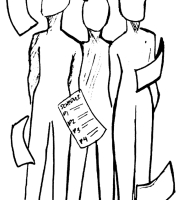
It will likely start like any other day. People will get up, brush their teeth and go to school or work. They’ll check their email, take their lunch break and talk with friends or colleagues. Everything will likely be exactly as it always is — up until the moment dogs across the Pacific Northwest will start barking, creating a kind of canine choir, prophesying our impending doom. Then, the shaking will start.
While the risks of “The Big One” — a potential 9.0 magnitude earthquake that could devastate the Pacific Northwest
— are fairly well-known, other types of earthquakes could also pose a significant threat to our lives and property.
In the last couple of years, geologists have discovered the presence of several fault lines in and around Portland, Oregon, with the potential to cause future earthquakes with sizable impacts on the greater metropolitan area.
“‘The Big One’ isn’t our only hazard, and (it) isn’t the only thing we should prepare for,” says Dr. Ashley Streig, an associate professor of geology at Portland State University.
The Pacific Northwest sits right in the middle of two tectonic titans locked in battle. To the west is the Juan de Fuca Plate, which is slowly subducting beneath the North American Plate, which comprises most of our continent. The interaction between these two plates is crucial to understanding the Pacific Northwest’s seismic hazards.
The opposing forces of the two plates essentially makes them stick together. The North American plate is compressed by the subducting Juan de Fuca plate, causing energy to build. When these forces become too much, the Juan de Fuca plate slips, while the North American plate lurches toward the Pacific Ocean. The resulting energy is released in the form of a Cascadia megathrust earthquake. This is “The Big One” that scientists refer to, a natural disaster beyond anything the Pacific Northwest has experienced in recent memory.
According to geologists, a Cascadia megathrust earthquake occurs every 350–500 years on average. Geologic evidence suggests that the last quake originating from a rupture of the Cascadia subduction zone occurred on Jan. 26, 1700,
meaning we are now roughly 320 years into this seismic cycle.
“That definitely puts us in a window where we can expect an earthquake on the subduction zone — if not in my lifetime, certainly in my child’s lifetime,” says Streig.
During an earthquake of this magnitude, there could be anywhere from three to seven minutes of shaking. Many of our buildings, unprepared for such sustained force, would crumble. Fifteen of the 17 bridges that connect Portland would likely be unusable. In areas with sandy soil and shallow groundwater, the ground would behave more like a liquid than a solid, causing structures built on them to collapse or even sink.
In Portland, this process could occur in areas along the Columbia and Willamette rivers — including the Northwest Industrial Area, where a large portion of the city’s fuel is stored. This could spill over 150 million gallons of hazardous chemicals into our waterways, according to a February 2022 study conducted by the Multnomah County Office of Sustainability and the City of Portland Bureau of Emergency Management.
While a Cascadia subduction zone earthquake is deeply concerning, it isn’t the only type of seismic event we could experience. Geologists have recently discovered multiple local faults in and around Portland that could potentially cause earthquakes. At least two of these faults are active: the Mount Angel fault, which had a 5.6-magnitude earthquake in 1993, and the Gales Creek fault, which was shown to have had recent seismic activity in research conducted by Streig and her master’s student Alison Horst. Streig says, “We have evidence that it’s had several surface rupturing earthquakes as large as magnitude seven in the last 8,000 years or so.”
In the case of any local fault earthquakes, the shaking would be intense due to our proximity to the epicenter and the shallow origins of these quakes.
“A Portland Hills fault earthquake, for example, would be very devastating for downtown Portland … There’s no distance of that diving plate that’s going to dampen the shaking or the effects of that type of an earthquake. Those (earthquakes) are very infrequent,” says Streig, “but still also a hazard and something that we need to think about.”
The fact that these faults might be set off by a Cascadia megathrust earthquake complicates matters further. The compression of the North American plate by the Juan de Fuca plate likely prevents these crustal faults from generating an earthquake by increasing clamping forces, preventing them from slipping. It is possible, Streig says, that a large subduction zone earthquake would relieve this clamping pressure, potentially allowing these crustal faults to relieve their own accumulated stress in an earthquake of their own.
According to the City of Portland’s website, about 1,600 unreinforced masonry buildings, or URMs, can be found throughout the city. These old buildings are at extreme risk of collapsing during an earthquake.
Portland Public Schools (PPS) has 23 schools on the Portland URM list. Many of these schools have had incremental improvements, such as roof upgrades or small interior reinforcements. However, only 10 PPS schools have been fully seismically upgraded and taken off the city’s URM list — Grant High School is one of them. Grant’s removal from the Portland URM list came about during the 2017–2019 remodel, which modernized and seismically retrofitted the building.
Safety features included concrete walls that extended all the way into the foundation, with a steel diaphragm built into concrete shear walls, allowing for weight load to be spread down into the ground. The old gym, which is now the arts building, was previously a URM building with a wooden frame. It was rebuilt with concrete shear walls and a wooden diaphragm roof, according to the remodel’s structural engineers KPFF Engineering, and PPS Bond Communications Manager David Mayne.
While URMs receive attention due to their cultural significance, there are many old houses in Portland that are at risk of severe earthquake damage, too. Michael Weiber, the co-founder and current owner of the retrofitting company NW Seismic, is concerned about Portland homeowners’ houses. When remodeling houses, NW Seismic aims to “retrofit (a) house to an extent that it would be repairable after an earthquake and (the residents) would be able to shelter in place after an earthquake,” Weiber says.
The problem starts in the house’s foundation. According to Weiber, foundations built around the 1930s used concrete that’s now crumbling and unstable. Portland neighborhoods have an abundance of houses that were built around this era, Hollywood and Richmond in particular. Weiber says, “A high percentage of those foundations
need to be replaced,” a process that could cost anywhere from four to six figures, depending on the building.
Location and concrete aren’t the only determining factors in whether or not a house survives an earthquake: Several popular architectural features in Portland leave houses with significant vulnerabilities. According to Weiber, houses with lots of big picture windows may have new concrete and engineering, but the largely glass walls will still have a hard time withstanding a strong earthquake in a multi-story home. Moreover, while they may be works of art, Portland’s beloved Victorian homes are simply not structurally prepared for an earthquake.
Oregon’s general building code does not cover a full seismic retrofit, leaving private companies to make their own
engineering standards that abide by the uniform building code. Weiber notes that for Portland’s residential buildings, “It’s a Wild West. You can do anything you want and call it a retrofit … There is no code. There is no standard that it’s held up to. There is no definition of a seismic retrofit.”
Other than retrofitting our homes, we don’t have much control over our city’s infrastructure. However, there are other things we can do to prepare ourselves. It’s important to have a plan with loved ones about what to do in the event of a major natural disaster, such as establishing a place to meet and a way to communicate if phone lines are down. It’s also important to stockpile food, water and other basic necessities to deal with a lack of running water or power.
While having emergency plans can help, there’s not much anyone can do if their house collapses on top of them. In order for Portland to truly be earthquake-safe in an environment where multiple different types of damaging earthquakes can occur, it will likely require a city-wide effort to improve infrastructure and retrofit existing buildings.
“Investments in infrastructure are always wise,”says Streig. “It’s cheaper to invest a little bit
more money now … than the whole building coming down and having to build another.”




